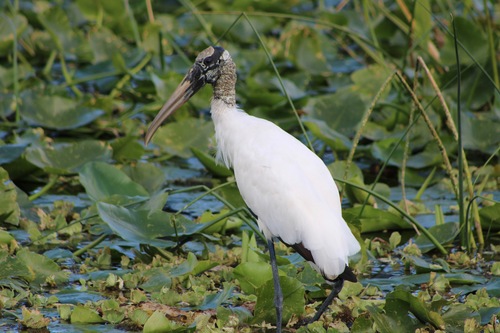
Wood Stork
The Wood Stork (*Mycteria americana*) is a large, bald-headed wading bird found in the Americas. It is the only stork species that regularly breeds in North America. Wood Storks are indicators of wetland ecosystem health, as their foraging success depends on specific hydrological conditions. They play a crucial role in controlling populations of fish and aquatic invertebrates. While not known for vibrant colors, their imposing size and unique tactile feeding method make them a fascinating subject of study.
83-115 cm
Length
140-180 cm
Wingspan
Least Concern
Conservation Status
Distribution
Wood Storks are found from the southeastern United States through Central America, the Caribbean, and much of South America, as far south as Argentina. They are largely non-migratory, though some populations may move seasonally in response to water levels. They are primarily found in lowland areas.
Lifespan
The oldest recorded Wood Stork in the wild lived over 22 years. Typical lifespan is likely shorter, around 11-18 years.
Wood Stork's Habitat
Habitat Types
Freshwater marshes, Swamps, Mangrove forests, Cypress swamps, Estuaries, Flooded agricultural fields
Climate Zones
Tropical, Subtropical, Warm temperate
Adaptations
Their long legs and tactile feeding method allow them to forage effectively in shallow, murky waters. Their bald heads are thought to prevent feather soiling when probing for prey.
Variations
No formally recognized subspecies exist, although there can be slight variations in size and plumage across their extensive range.
Appearance
Breeding Plumage
Adult plumage is largely white. During the breeding season, the legs and feet become brighter pink.
Seasonal Feather Changes
Limited seasonal variation beyond the leg color change during breeding.
Sex Based Plumage Differences
Minimal sexual dimorphism in plumage; males and females appear similar.
Notable Features
Bald, dark gray head and neck, Long, thick, decurved bill, Black flight feathers contrasting with white body plumage, Long, dark legs (bright pink during breeding)
Diet and Feeding
Primary Foods
Small fish, Crustaceans, Amphibians, Aquatic insects, Reptiles(small snakes and turtles)
Foraging Behavior
Wood Storks are tactile feeders. They wade in shallow water, sweeping their partially opened bills back and forth. When they touch prey, they snap their bills shut with remarkable speed.
Specializations
The highly sensitive bill with specialized nerve receptors allows for rapid prey capture in murky water. They often forage in groups, which may help concentrate prey.
Seasonal Diet Variations
Diet composition varies depending on prey availability, which is influenced by water levels and seasonal flooding. During dry periods, they may consume more crustaceans.
Behavior
Social Structure
Wood Storks are highly social, often foraging, roosting, and nesting in large colonies. Outside of the breeding season, they may form large aggregations at favorable feeding sites.
Communication
Bill-clattering (during courtship and territorial displays), Hissing sounds (especially by chicks), Croaking vocalizations (relatively quiet compared to some other storks)
Migration
While not long-distance migrants, Wood Storks may undertake regional movements in response to changing water conditions. They are considered partial migrants.
Territorial or Group Behaviors
Within breeding colonies, Wood Storks defend a small territory around their nest. They are generally not highly territorial outside of the breeding season.
Conservation
Threats
Habitat loss and degradation (due to drainage of wetlands), Alteration of natural water regimes (through dams and canals), Pollution (pesticides and heavy metals), Climate change (leading to sea-level rise and altered rainfall patterns), Human disturbance at nesting colonies
Protection Programs
Wetland restoration and protection efforts, Management of water levels to mimic natural cycles, Monitoring of breeding colonies, Endangered Species Act (in the US, listed as Threatened in 1984, downlisted to Threatened in 2014)
Local National Laws
Protected under the U.S. Migratory Bird Treaty Act and various state laws. International protection through CITES Appendix II.
Population Trend
Increasing in some areas (e.g., the southeastern US), but still declining or stable in others. Overall, the global population trend is considered to be increasing.
Population Estimates
The global population is estimated to be around 150,000-400,000 individuals.
Interesting Facts
Wood Storks have one of the fastest reflex responses of any vertebrate.
Their bill snap reflex takes only 25 milliseconds, allowing them to capture fast-moving prey.
They sometimes use their wings to shade the water while foraging.
This may help them see prey more easily or attract fish to the shade.
Wood Storks often soar on thermals, reaching considerable altitudes.
This allows them to conserve energy while searching for foraging areas or moving between roosting and feeding sites.
The Wood Stork's scientific name, *Mycteria*, comes from the Greek word *mykter*, meaning 'nose'.
This alludes to their long and prominent bill.
Faqs about Wood Stork
Are Wood Storks endangered?
The Wood Stork was listed as Endangered in the United States in 1984 but was downlisted to Threatened in 2014 due to population recovery. Globally, it is classified as Least Concern by the IUCN.
What do Wood Storks eat?
They primarily eat small fish, but also consume crustaceans, amphibians, aquatic insects, and occasionally small reptiles.
Where do Wood Storks nest?
They build large stick nests in trees, often in colonies located in swamps, mangroves, or other wetlands.
Do Wood Storks Migrate?
They are not long-distance migrants. They are considered partial migrants and make short-distance migrations.
Copyright @ Nature Style Limited. All Rights Reserved.
 English
English